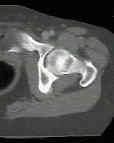- Femoral Anteversion: 
- femoral version is defined as the angular difference between axis of femoral neck and transcondylar axis of the knee;
- normal values:
- on average, femoral anteversion ranges from 30-40 deg at birth and decreases progressively throughout growth to
about 15 deg at skeletal maturation;
- in adults, anteversion averages between 8 and 14 deg, w/ an average of 8 degrees in men and 14 degrees in women;
- exam:
- medial rotation of thigh in extension exceeding 70 deg is abnormal;
- Reider Test:
- prominence of the greater trochanter indicates axis of the femoral neck;
- noting the position of the patella, an accurate determination of the femoral anteversion can be determined;
- Determination of Anteversion during THR: (see determination of acetabular anteversion and dislocation)
- probably the least accurate method is to gage anteversion off of the lesser trochanter or the thickness of the calcar;
- the most accurate method is to fully internally rotate the hip and to hold the tibia straight upwards;
- horizontal then indicates zero anteversion, and component is placed in anteversion as it is rotated towards buttocks (using the posterior approach);
- as broach is driven into the femur, it may rotate slight into anteversion
- references:
Computed Tomography Measurement of the Accuracy of Component Version in Total Hip Arthroplasty.
Computed tomographic evaluation of component position on dislocation after total hip arthroplasty.
The effect of anteversion on femoral component stability assessed by radiostereometric analysis
Combined Anteversion Technique for Total Hip Arthroplasty
Re: Increased anteversion of press-fit femoral stems compared with anatomic femur.
The role of femoral neck anteversion in the development of osteoarthritis in dysplastic hips.

